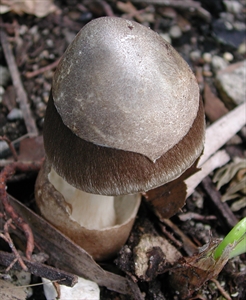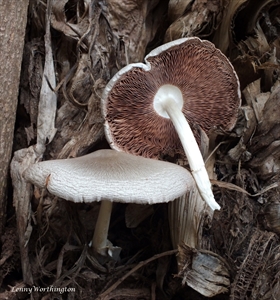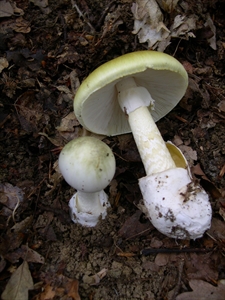Paddy straw mushroom, straw mushroom, Chinese mushroom.
Pacific Pests, Pathogens, Weeds & Pesticides - Online edition
Pacific Pests, Pathogens, Weeds & Pesticides
Paddy straw mushroom (433)
Volvariella volvacea
It is cultivated widely in East and Southeast Asia, and introduced in many other regions, including Africa, North America and Australia. It is recorded from Solomon Islands.
The paddy straw mushroom is grown on rice straw beds and picked immature, during the button or egg phase and before the veil ruptures (Photo 1). It is found in woodchips, rich garden soil, compost piles and, in the Pacific, on decaying trunks of fallen sago palm and empty fruit bunches of oil palm. They are often available fresh in Asia, but are more frequently found canned or dried in countries where they are not cultivated.
Methods of cultivation are here: http://www.fao.org/3/ca4450en/ca4450en.pdf.
Young stages are formed under a greyish-brown veil (‘universal veil’), which surrounds the mushroom at the ‘button stage’ (Photo 2). It breaks to allow the stem and cap to expand leaving a dark brown cup-shaped structure (the ‘volva’) at the base (Photo 2).
The cap is 5-12 cm diameter, first ovoid, then cone-like and finally broadly convex or bell-shaped, dark grey in the centre, becoming silvery-white or brownish-grey towards the margins, radially streaked with soft hairs (Photo 3). The cap tends to split at the edges. Gills are free from the stem, white then pinkish, and finally brownish-pink. Stem 6-12 cm, whitish or brown.
In the button stage, the paddy straw mushroom is like the highly poisonous death cap Amanita phalloides, which contains alpha-amantin. If the death cap is eaten by human beings it results in liver and kidney failure. The toxin is not destroyed by cooking, and eating half a mushroom is sufficient to kill an adult.
The paddy straw mushroom can be distinguished from the death cap by its pink spore print (that of the death cap is white), and the lack of a ring on the stem (stipe) (Photo 4) - a white membranous ring is present on the death cap (Photo 5). The two mushrooms have different distributions, with the death cap generally not found where the straw mushroom grows natively, but introductions have occurred, e.g., Australia and North America, where the death cap grows as an ectomycorrhiza fungus on the roots of introduced forest species, e.g., oak, chestnut and pine.
However, the two cannot be distinguished in the button stage, and that is when people consider the paddy straw mushroom is best for consumption.
AUTHOR Grahame Jackson
Information from Pacioni G (1993) The MacDomald Encyclopedia of mushrooms and toadstools. Little, Brown and Company (UK) Limited. London; and Volvariella volvacea. Wikipedia. (https://en.wikipedia.org/wiki/Volvariella_volvacea); and Amanita phalloides. Wikipedia. (https://en.wikipedia.org/wiki/Amanita_phalloides); and Kuo M (2018) Volvariella volvacea. Mushroom Expert.Com. (http://www.mushroomexpert.com/volvariella_volvacea.html); and from FAO (2017) Straw mushroom (Volvariella volvacea) cultivation for livelihood diversification in Laos. Food and Agriculture Organization of the United Nations. (http://www.fao.org/3/ca4450en/ca4450en.pdf). Photo 1 Chong Fat (https://commons.wikimedia.org/wiki/File:StrawMushroom.jpg). Photo 4 Len Worthington Volvariella volvacea (Bul.) Singer (1951). (https://www.flickr.com/photos/lennyworthington/16265718515/). Photo 5 Archenzo. Amanita phalloides. Piacenza's mountains (https://en.wikipedia.org/wiki/Amanita_phalloides).
Produced with support from the Australian Centre for International Agricultural Research under project HORT/2016/185: Responding to emerging pest and disease threats to horticulture in the Pacific islands, implemented by the University of Queensland and the Secretariat of the Pacific Community.








